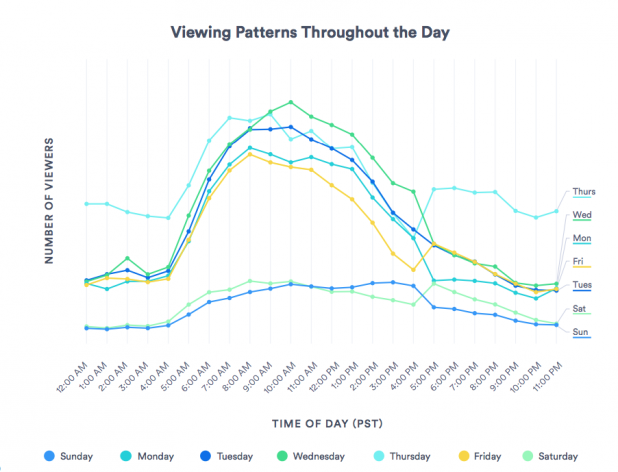The popularity of video marketing has gone viral in the same fashion as the rise of social media. Despite video marketing statistics that show an increased consumer preference for online videos, marketers are yet to catch up with video marketing strategies fully or aren’t getting the best results.
If you’re looking for the right information on marketing strategies that can help you get the best possible return on investment (ROI) from video campaigns, then please read on as I break down 15 video marketing stats that your business needs to know in 2020.
1. Videos increase Consumer in Purchasing Decisions
Consumers most often tend to skip parts of audio and written content. If you wish to keep them engaged long enough to decide on making a purchase, then a video is an excellent way to go. A survey carried out by Wyzowl shows that out of every ten users, eight purchased a piece of software or app after watching the brand’s video. The same survey also showed that 96% of users turn to videos to get more info about a particular product or service.
According to Google, video influences online consumers by acting as a shopping list that reminds them of the items they wish to purchase. Also, it arms them with enough information and confidence to complete a purchase or see product reviews.
2. On Weekdays Consumers Watch More Videos in The Mornings
Despite fluctuations, consumers are likely to watch video marketing content in the mornings if it’s a weekday.

These video marketing statistics are vital for timing when best to post videos and get engagement from consumers. It is also a trend that will likely remain crucial for video marketing in 2020 and beyond.
3. Consumers Want Videos to Reflect Their Interests
Although videos carry a lot of entertainment, it is essential that they also capture the interest of the consumer. If not, your video marketing strategies will be dead on arrival. Video marketing stats show that consumers want videos that meet their expectations. The numbers show that 48% of consumers wish videos to reflect precisely the product or service they are viewing.
Further studies on HubSpot show that 54% of consumers are interested in seeing more video content from their favourite brand or business. The increasing demand for videos goes to show that more industry influencers need to proactively create different types of video content to meet consumer needs.
4. Increased Length of Video Advertisements
Despite the notion that the consumer attention span has grown shorter, the same is not the case with video advertising. Video marketing statistics in the third quarter of 2019 showed that 66% of video adverts were 30 seconds long, which is a 10% increase from 55% in the third quarter of 2018. Irrespective of the increase in the length of video ads, they were still seen as useful.
5. Video marketing isn’t just B2C-focused
Although video marketing is often mainly seen as a powerful Business-to-Consumer tool, particularly on social media platforms, Business-to-Business companies are likewise looking to increase video leads and conversions. Interesting stats show that 41% of B2B marketers are moving towards including videos to their marketing and sales strategies for 2020 and beyond.
It’s also worth noting that 22% of Business-to-Business companies are interested in investing in the opportunities provided by podcasting and live streaming. This projection suggests that there are likely opportunities in these areas.
6. By 2021 Consumers Will Spend 100 Minutes a Day Watching Online Videos
It is estimated that the average consumer will spend 100 minutes per day watching online videos by 2021, meaning viewing minutes will increase by 16 minutes from 84 minutes as of 2019.
In explaining this trend, the head of forecasting at Zenith, Jonathan Barnard, equates it to the average person spending half as much time watching videos online as they spend watching conventional TV 2020.
7. Small and Medium-Sized Businesses Use Both Internal and External Resources to Create Videos
To meet their video production targets, both small and medium companies, use external and internal resources.

Businesses often first look inwards to see what they can accomplish in-house before getting external assistance to fill in gaps.
8. High profits in Video Marketing
A report by Animoto shows that 88% of video marketers are satisfied with the ROI from their video marketing strategies. The same report also indicates that 80% of marketers show satisfaction with the ROI from video ads posted on social media platforms.
What companies are doing is to build brand awareness, provide relevant information for old and potential customers, and ultimately drive sales with the use of video marketing. Brands are achieving this using social media platforms such as Instagram, YouTube, Facebook, etc. to post marketing videos and ads.
9. High Number of Teens Watching Online Videos in the USA Every Day
If your product or service is targeted at the teenage audience, then these video marketing stats should excite you. The 2019 demographics for daily online video consumption of younger people aged 13-19 are at 66% and 56% for tweens aged 8-12 in the US. These numbers are a considerable increase from statistics from about five years ago.
10. Consumers Love Seeing Videos on Social Media
According to statica.com, in 2019, 2.28 billion people made use of social media, and this number is projected to increase. What’s more interesting is that videos are consumers’ favourite type of social media content. As they scroll through Instagram, Facebook, Pinterest, YouTube, and the like, they are looking out for the best video content to engage with.
According to a 2018 report by the State of Social Video Marketing Trends, 73% of users said they were influenced by the social media presence of a brand when making a purchasing decision.
As more consumers are influenced by video marketing, it isn’t surprising that Instagram is poised to become the fastest-growing social media platform that uses video content to drive purchases.
11. Videos Increase Internet Traffic
With the growth of video ads, there are also indications of an increase in market share in internet traffic. Cisco estimated that by 2022, 82% of internet traffic worldwide would stem from video streaming and downloads. That’s to say 240 Exabytes (1 Exabyte is equal to 1 000 000 000 000 gigabytes) of internet video will be seen per month by 2022.
The study also shows that traffic from live internet videos will increase by 15-fold between 2017 and 2022 and will amount to a 17% increase in the total internet video traffic share by 2022. It is a video marketing statistic worth considering, especially if you make use of Instagram or Facebook live videos to market your brand’s dropshipping business!
12. Companies With 31-200 Employees Create Nearly as Many Videos as Those Five Times Their Size
The size of a company does not necessarily determine its video production capabilities. The chart below shows that companies with at least 5,000 employees created only 28 videos more than those with a team member count in the 31-200 range.

What this means is that irrespective of a company being a start-up or a large corporation all can benefit from video marketing.
13. Brands Share Videos Through Their Websites 85% of the time
As we have already seen, most brands share their marketing videos through multiple channels, including social media, email, etc. However, websites also rack up very high video marketing statistics.
This is a no brainer because a company’s website is their online base.
14. Videos in Emails Improve Click-Through Rates
Attaching a video in an email increases the click-through rate by 200 to 300%. A lot of businesses are successfully adopting this video email marketing strategy.
15. Including a Video on Your Website Landing Page
Including a video on your site’s landing page, leads to an increase in conversions by as much as 80%. The resultant effect of this is that it increases the length of time consumers stay on your website, allowing them to engage with your product much longer.
Conclusion
This basically sums up all you need to know about video marketing stats for 2020. I hope it helps your brand implement video marketing strategies for your eCommerce business successfully!




